The expression “turtles all the way down” has never been so apt as with Peperomia prostrata, the so-called String of Turtles.
This charming trailing vine with thick, round leaves really does look the part.
Thanks to the deep emerald markings (or purple on mature plants) contrasting the beautiful light green/white veins, the turtle shell illusion is complete.
It’s the cute animal-themed plant I never knew I needed!
Despite its semi-succulent inclinations, Peperomia prostrata is a surprisingly versatile tropical plant and a common feature in – and out – of terrariums, planters, and pots around the world.
Let’s get into it.
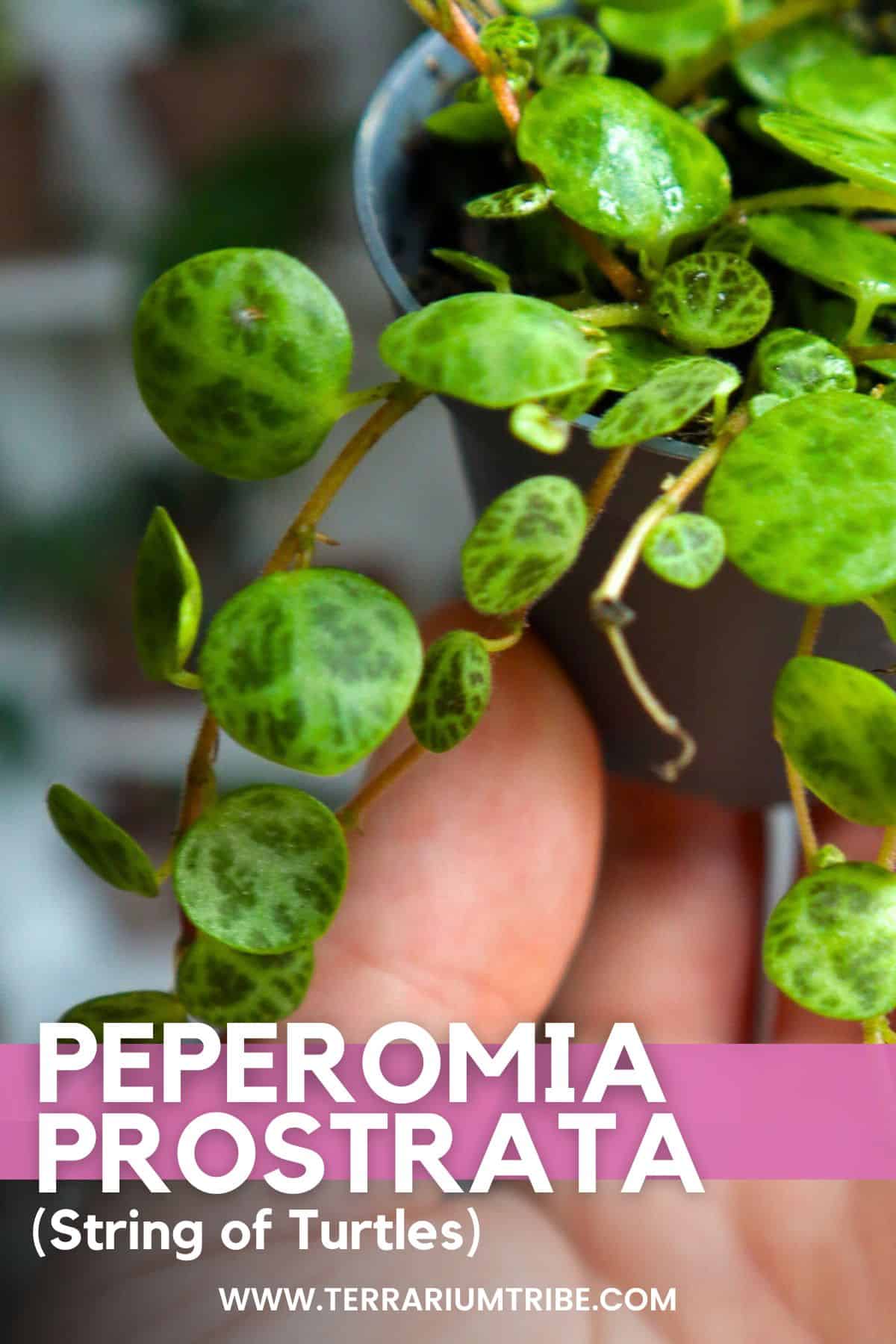
What is a String of Turtles? (Besides the Cutest Name for a Plant)
The String of Turtles is regarded as a semi-succulent plant, but don’t let that word fool you.
Hailing from the rainforests of South America, the String of Turtles is still very much a tropical plant with a love of moisture, humidity, and warmer temperatures.
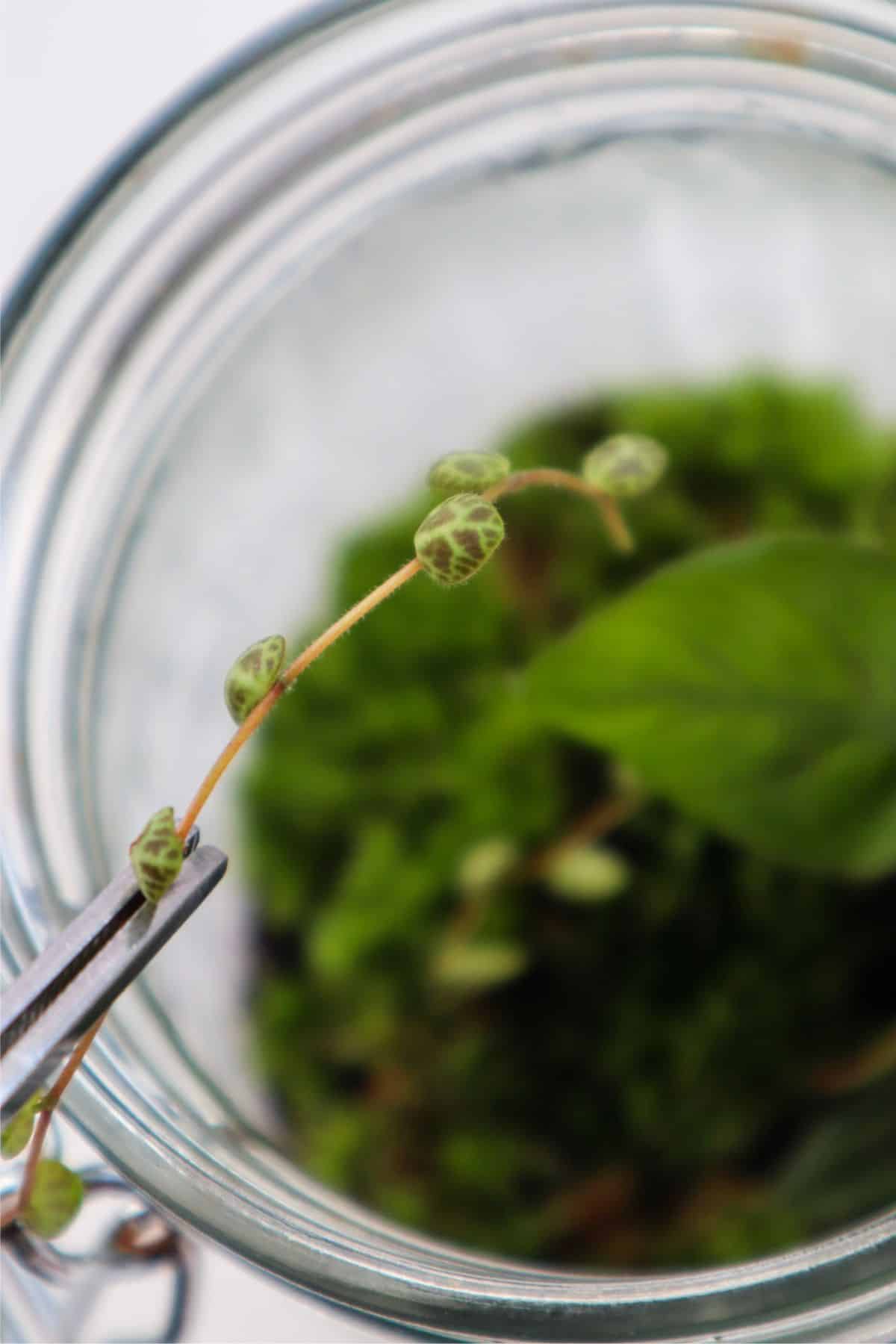
However, that tropical/succulent duality does come into play when it comes to plant care for this unique species (more on that later).
These vining plants are actually epiphytes in the wild, meaning you’ll find them attached to the sides of trees and other large plants.
Recreating this in the home is not only beneficial for their health and growth but mounting them high in a basket or at the top of a terrarium can produce a stunning cascade effect as the vines spill over the edge.
Whether you’re growing these as an indoor plant or a terrarium/container garden feature – they’re a stunning (and easy) choice!
Where to Buy String of Turtles
See the links below to purchase from reputable terrarium plant shops and marketplaces (may include affiliate links).
Peperomia prostrata Care & Growth
At a Glance
| Plant Type | Vine, epiphyte |
| Lighting | Bright, indirect light |
| Temperature | 65-80°F (18-26°C) |
| Watering | Infrequent, even moisture |
| Humidity | High humidity (60-90%) |
| Growth | 1-2 inches tall, 3+ metres long |
Lighting
Lighting is one area where this so-called succulent does not fit the bill.
Where most succulents need lots of direct light, the succulent leaves of the String of Turtles will quickly suffer under such harsh sunlight conditions.
Instead – like many other great tropical species – Peperomia prostrata will do best in bright indirect light.
In the home, North-facing windows would be best for consistent soft lighting, followed by East-facing if your morning sunlight isn’t too strong.
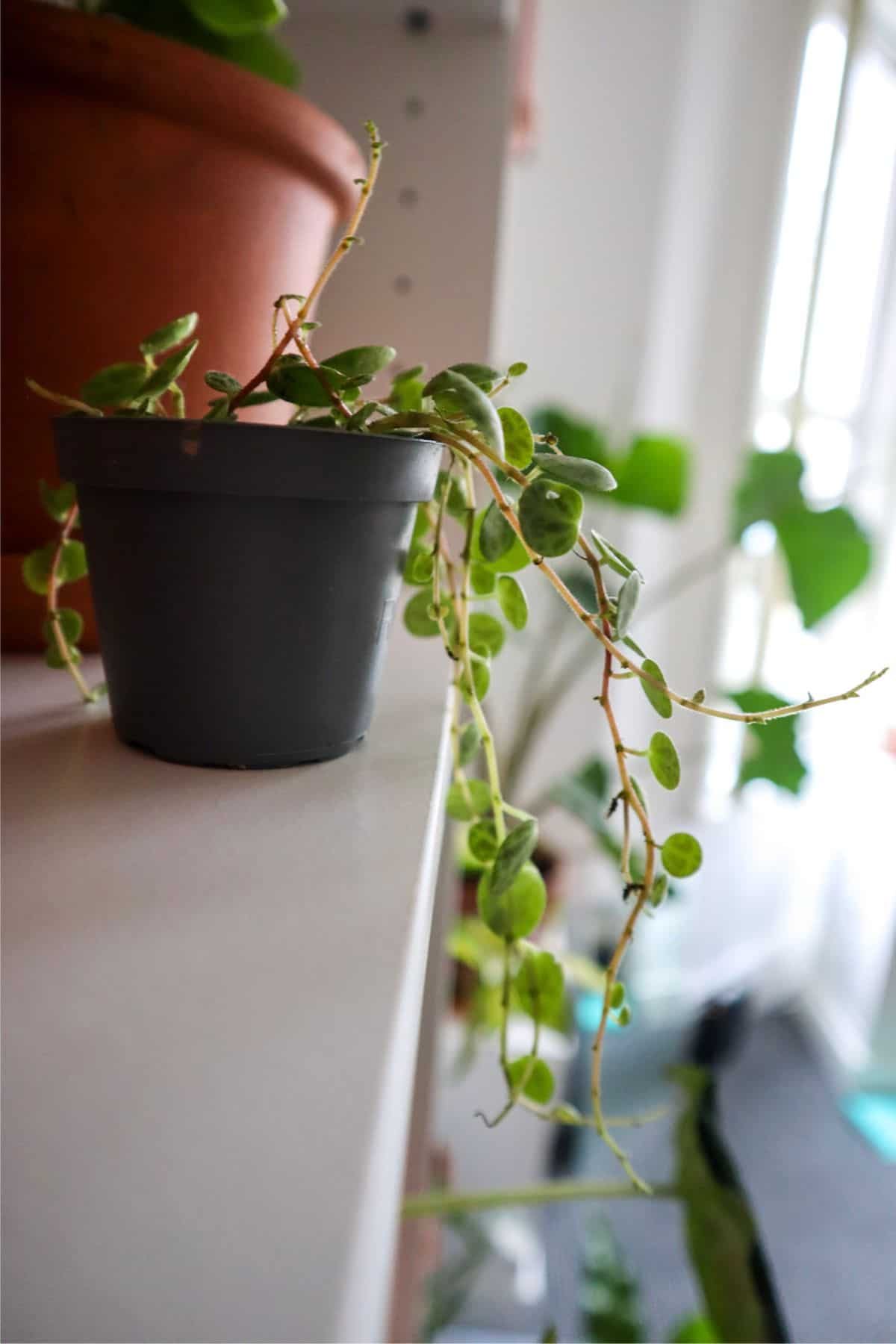
Alternatively, you can use an artificial light solution to provide consistent, safe light levels.
It’ll actually manage pretty well in low light conditions, too, but you’ll want to give it more if you want the most vibrant and beautiful pattern for your plant.
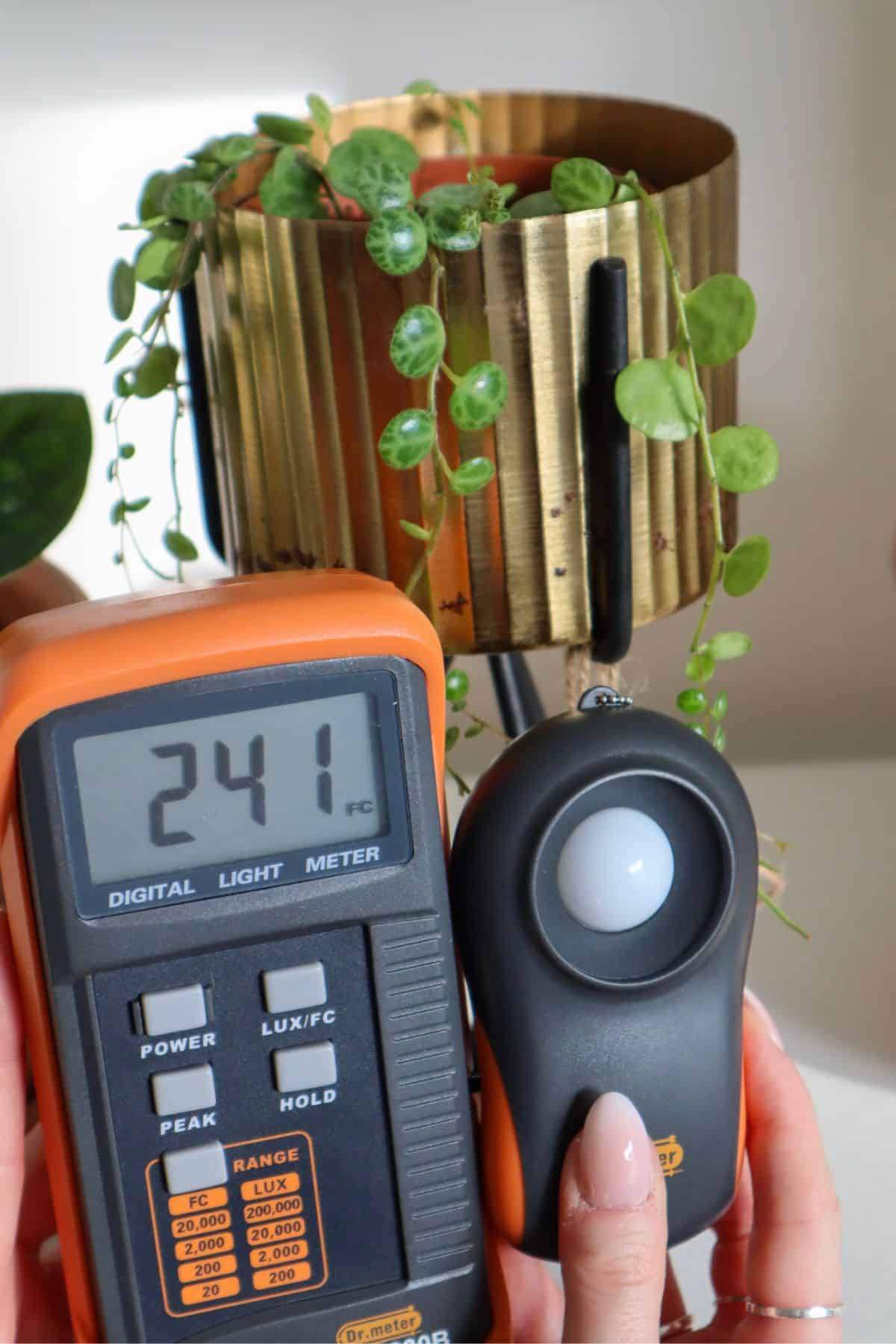
Watering
When it comes to watering, Peperomia prostrata is very much the succulent type.
It’s able to store plenty of water in those thick, juicy leaves, so overwatering this plant is a quick way to turn your String of Turtles plant into turtle soup…
So, it’s really important to get this right.
Consider what watering cycle it’s going to receive in the wild, and try to match that in your home.
As an epiphyte growing on trees in the wilds of the Ecuadorian rainforest, Peperomia prostrata would be constantly going through a cycle of getting soaked by the rain and then dried by the intense heat of the environment.
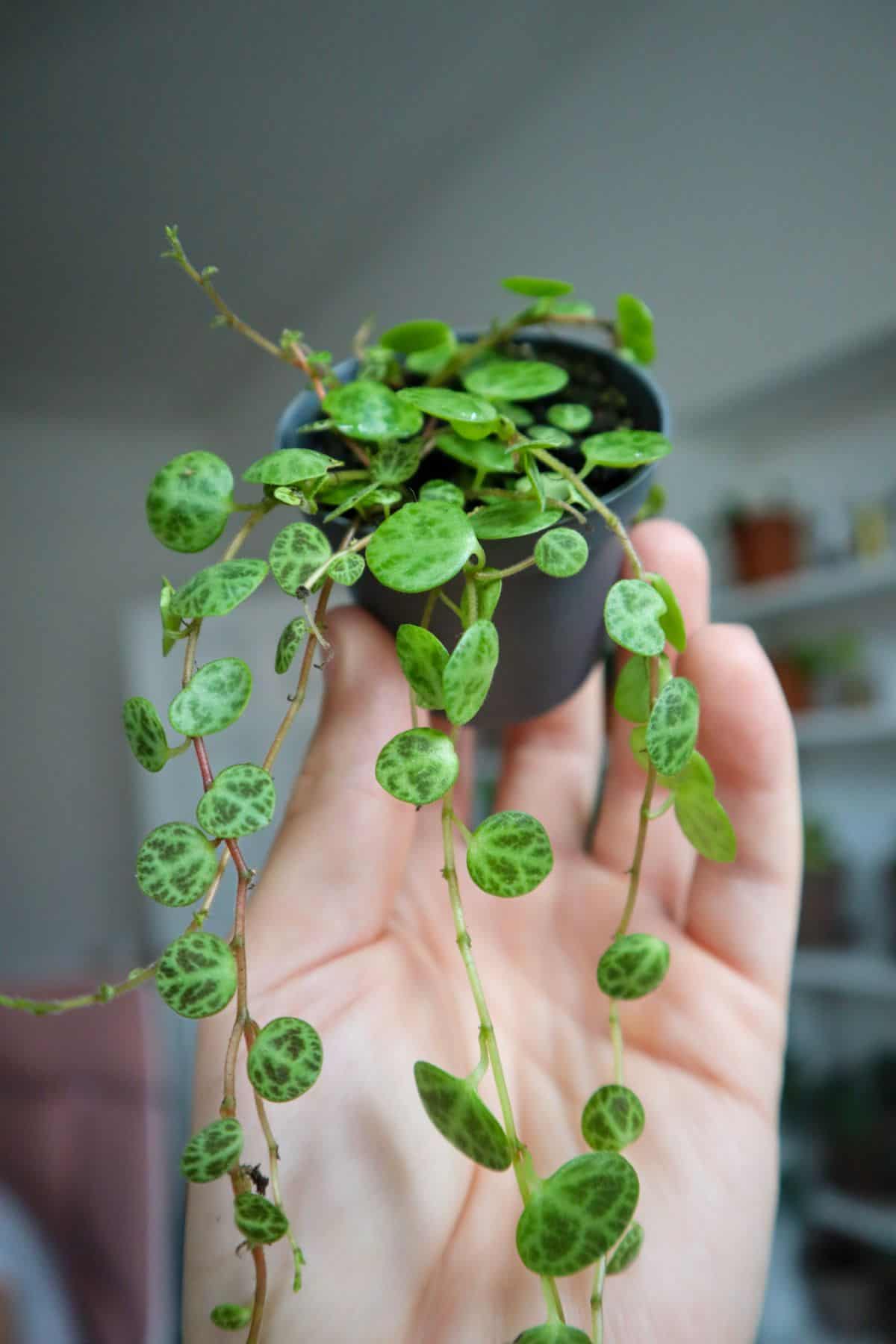
You want evenly moist soil, not desperately waterlogged soil.
- So, in a pot, this means letting your plant dry out a little before watering but thoroughly watering it when it needs it. Also, having a drainage hole is essential so that excess water can escape.
- In a terrarium, though all this sounds like a recipe for disaster (and/or soup), this challenge can be overcome through the use of the right substrate mix and watering technique.
Or, this challenge can be circumvented entirely by using it as an epiphyte and simply misting it down every now and again.
If mounted epiphytically, as long as the material can hold moisture (e.g., tree fern fiber or cork board), then the String of Turtles will be able to access that through its epiphytic vining roots.
Substrate
So, how about we jump into that ideal substrate mix I talked about earlier?
If you’re planting your String of Turtles, to reduce the chance of overwatering – and that much-feared risk of root rot – a well-draining substrate is essential.
Soggy soil is a big no-no.
However, the roots of the String of Turtles are pretty small, and they won’t be able to penetrate deep into a substrate to reach moisture (especially if it’s really chunky). So, it’s still important to have a mix with some decent water retention.
A tropical mix using a coco coir base and earthworm castings for nutrients, plus plenty of perlite/vermiculite or pumice, would work well.
👉 Check out our tropical terrarium mix – it’s a natural fit here.
On the flip side, if you’re mounting this bad boy as an epiphyte – you don’t need to worry about substrate at all.
In fact, in a terrarium, you don’t even need to mount it. You can just place a cutting on top of your soil, moss, or plants, and it will readily attach itself.
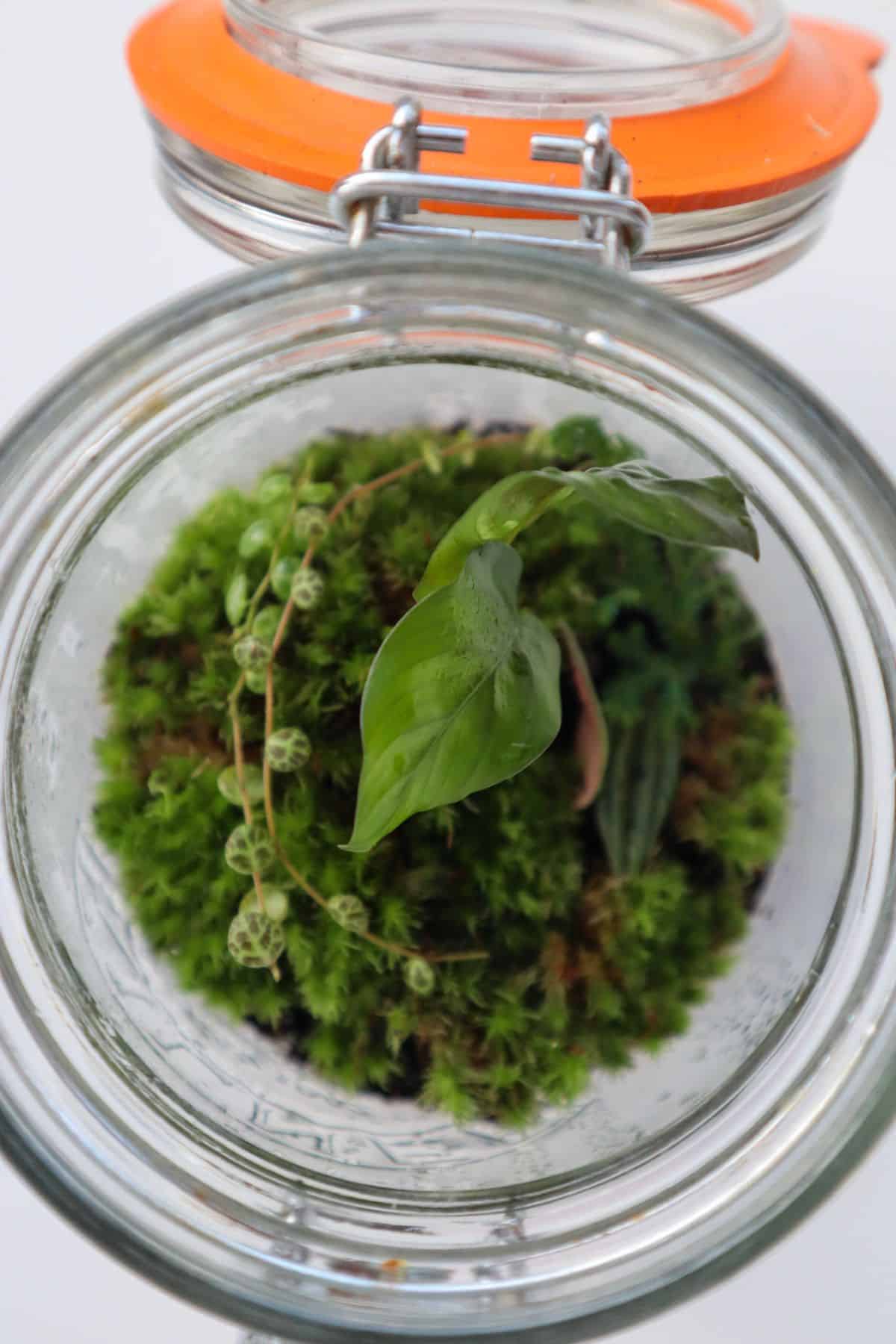
It’s that easy.
Temperature & Humidity
Despite its succulent nature, the String of Turtles still favors warm and humid environments.
You don’t need to be reaching rainforest humidity levels, but if you can… it will love you forever.
I mean, that’s precisely what a closed terrarium provides, so it’s no wonder you’ll see this plant absolutely thrive in those conditions.
In the home, a high humidity helps but isn’t absolutely necessary. Anything above 60% will work great (it’s naturally at least that here in the UK), but if you’re struggling, Peperomia prostrata makes a great bathroom plant!
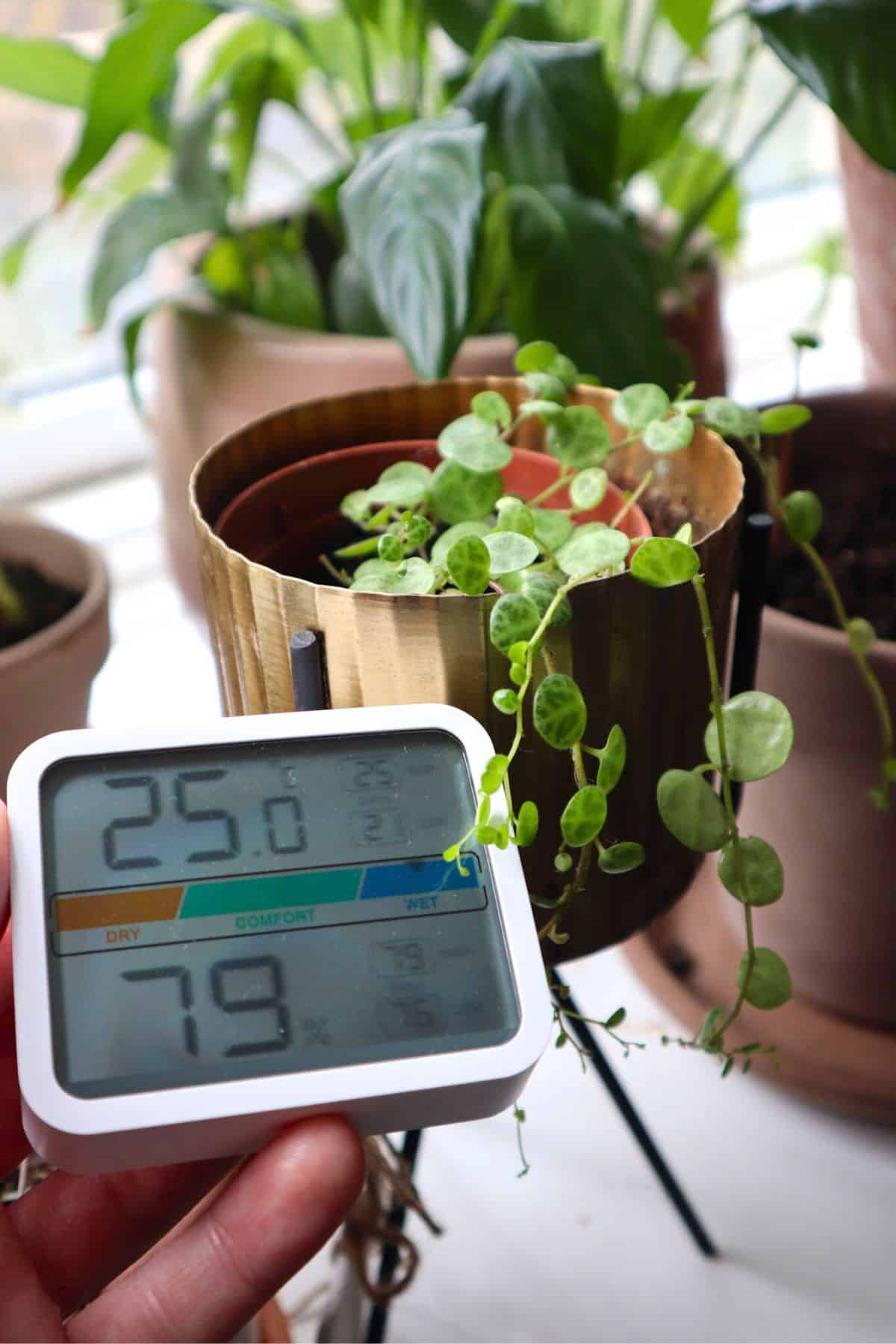
It’s much more sensitive to the cold, so you really want to protect your plant in the colder Winter months.
Growth
Peperomia prostrata grows relatively slowly (especially for a vine), but given enough time, it can fill out.
If you want a thick cascading effect, you’ll have an easier time if you trim it occasionally to encourage it to branch into new growth. Otherwise, you’ll end up with a very long and very thin plant.
Besides, you can use those cuttings to propagate some more plants to add back in!
Win-win.
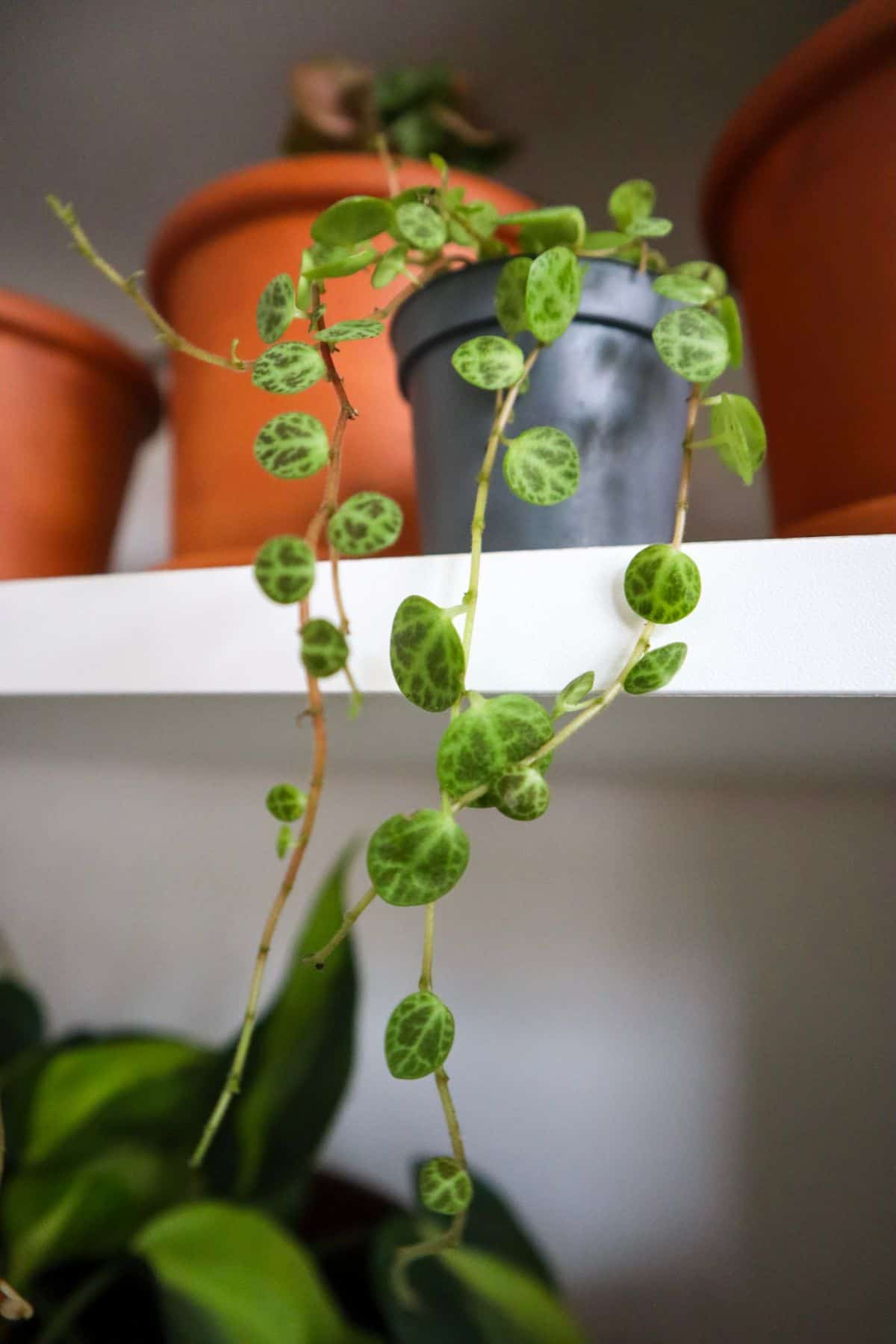
With relatively slow plant growth, it’s not going to need a whole lot of fertilizing, either. If you’ve mounted it, you can always top it up with a small amount of liquid fertilizer if you feel it really needs it.
It’s also worth noting that the prostrata is a flowering species, but in true Peperomia fashion, they’re not particularly pretty…

Propagation
The String of Turtles is an absolute breeze to propagate from stem cuttings.
Simply snip off a stretch of healthy plant with at least one viable node and a handful of leaves, and it should happily root in a variety of mediums.
Substrate Propagation
Unlike cuttings from other plants, you can simply lay your cuttings directly onto your propagation medium. You really don’t need to use much, though. A shallow layer is plenty for those small roots.
Pure sphagnum moss is often used for its excellent water retention (which helps boost humidity), and it has pretty good airflow on its own. Or, personally, I’d opt for a sphagnum blend with lots of perlite or lava rock just to balance all that moisture.
That being said, I’d absolutely recommend you use a sealed container to trap the humidity. Having tonnes of moisture in the air is what is going to really encourage those roots to form. Rooting hormones can help here, too.
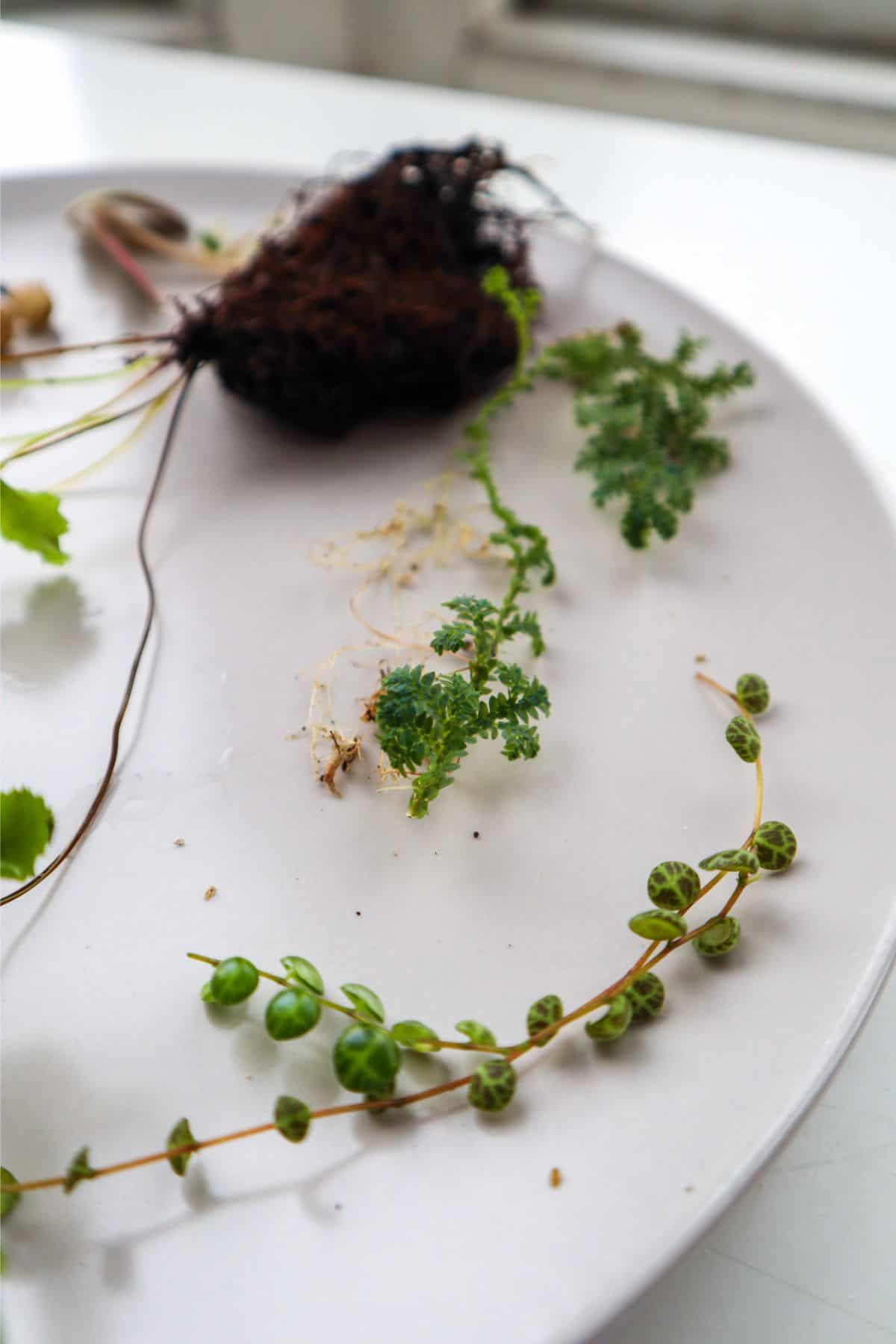
Water Propagation
Water propagation is a method that works well for many trailing “String of” succulent varieties.
Simply pop your stem cuttings into a bottle/pot of water and watch the magic happen!
You’ll need longer cuttings of the healthiest stems, as the lower leaves should be removed from the stretch that’s going to go into the water.
I’ve yet to try it with my String of Turtles, but it’s working well with our String of Hearts.
I’d say water propagation is probably the least fuss, but I don’t think it has quite the same success rate.
For all of these methods, you should see root growth in a couple of weeks.
Varieties & Similar Plants
Despite the wide variety of Peperomia plants, there are only a few varieties of Peperomia prostrata.
- There’s a ‘Silver Stripe’ variety, which seems to be the newest and prettiest kid on the block; currently reflected in its price tag and rarity.
- If you love a classic, there’s also Peperomia prostrata ‘Pepperspot’ (String of coins) with fabulously deep green leaves.
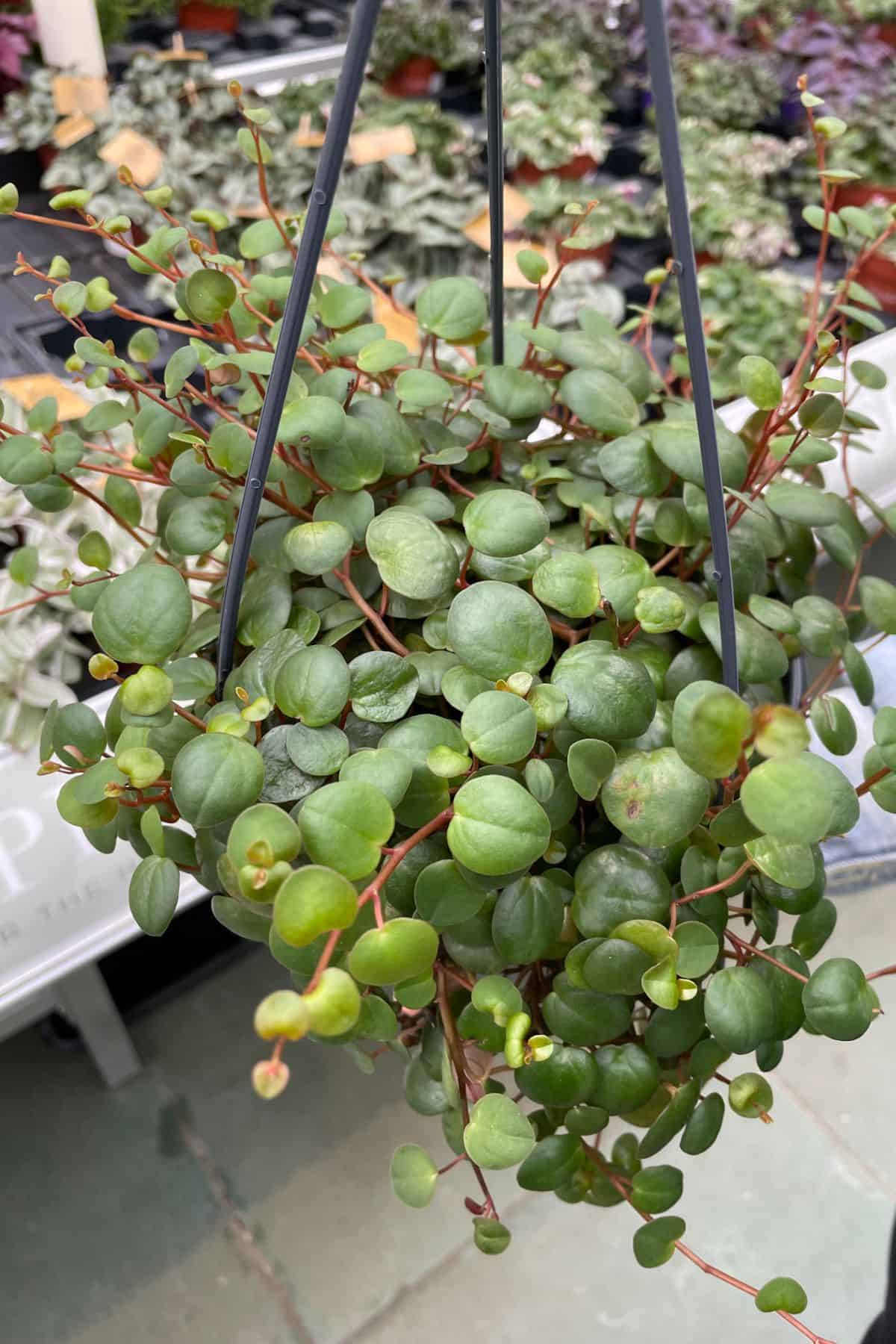
But don’t let your search end there, there are many other types of Radiator plants that are amazing terrarium species, e.g., Peperomia rotundifolia (Trailing Jade), Peperomia Rosso and Peperomia Hope.
Not to mention the similar succulent-like vining plant species such as the Ceropegia woodii (String of Hearts) and Senecio rowleyanus (String of Pearls).
Frequently Asked Questions
The String of Turtles is not considered to be a rare plant and is commercially available in most Western countries.
The String of Turtles is considered to be semi-succulent due to its ability to store moisture in its thick leaves. However, it doesn’t share all of the other qualities of a typical succulent, e.g., a preference for high sunlight and low humidity.
The String of Turtles isn’t a particularly fast grower, though given enough time and the right conditions, it can fill out nicely.
The String of Turtles can bloom with small white flowers along the vine once the plant has reached a certain level of maturity.
As a tropical plant, the String of Turtles thrives in high-humidity environments. However, household conditions are often enough to keep this plant happy enough.
The String of Turtles is not overly susceptible to common pests, but it has been known to attract mealy bugs and spider mites. Any infected plant should be cleaned with insecticidal soap.
